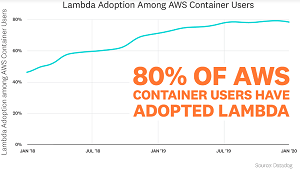News
Report: AWS Lambda Is Big Serverless Computing Hit, Especially with Containers
Cloud application monitoring specialist Datadog published a report on AWS Lambda, the cloud giant's serverless computing platform, finding it's enjoying tremendous popularity among AWS users, especially those who are also using containers.
The report actually examines "The State of Serverless" but focuses on market leader AWS, based on usage data from thousands of organizations using the dominant cloud computing platform.
"'Serverless' may be a buzzword, but it's not an empty one. Less than five years since it launched, AWS Lambda has already been adopted by nearly half of companies with infrastructure in AWS," says the report, which specifically focuses on functions-as-a-service (FaaS). That is a subset of serverless computing that features pay-as-you-go pricing models common in the public cloud, but with an emphasis on “functions” rather than infrastructure components. Functions, the report states, are just code constructs that perform a discrete unit of business logic when invoked events such as a user request.
Datadog says AWS Lambda can perform specific tasks within an existing architecture, such as:
- Automatically resizing images after they are uploaded to an Amazon S3 bucket
- Serving as a cron job to schedule the startup or shutdown of EC2 instances with AWS CloudWatch Events
- Creating AWS CloudTrail security policies for newly launched EC2 instances
- Serving as a backend to process API requests and retrieve data from a data store like DynamoDB
"At the dawn of 2020, Lambda is no longer a niche technology," the report states. "Nearly half of Datadog customers that use Amazon Web Services have now adopted Lambda. This adoption rate, along with the breakdown of Lambda usage by environment size ... shows that Lambda is no longer limited to cloud-native early adopters or niche use cases. On the contrary, serverless functions are now in widespread use across a variety of companies with an infrastructure footprint in AWS."
 [Click on image for larger view.] Lambda Adoption Among AWS Container Users (source: Datadog).
[Click on image for larger view.] Lambda Adoption Among AWS Container Users (source: Datadog).
Organizations using container technologies are even more likely to avail themselves of serverless computing on the Amazon cloud. "As of January 2020, nearly 80 percent of organizations in AWS that are running containers have adopted Lambda," the report says. "Although serverless functions and containers are two very different environments, they tend to be embraced for similar reasons, such as abstracting away infrastructure concerns for ease of operations."
Other highlights of the report include:
- Lambda is more prevalent in large environments: "Perhaps surprisingly, the widespread adoption of Lambda has not been driven by newer, smaller companies. Rather, we see a clear correlation between Lambda adoption and the scale of a company's infrastructure environment, whether that environment is primarily servers, containers, or serverless functions."
- Amazon SQS and DynamoDB pair well with Lambda: "Lambda users have a vast array of technology choices when it comes to connecting their functions to infrastructure and application components. Once a function is triggered, it often sends the data it produces to a message queue, which routes the data onward to other Lambda functions, server-based applications, or cloud services."
- Node.js and Python dominate among Lambda users: "Among the languages and frameworks available to Lambda users, we see two clear leaders in terms of usage: Python and JavaScript (via Node.js). 47 percent of all deployed Lambdas currently run Python, with another 39 percent running Node.js applications. Python 3 outweighs Python 2 (which reached end of life in January 2020) by a factor of two to one."
- The median Lambda function runs for 800 milliseconds: "The median Lambda function runs for about 800 milliseconds, averaged across all its invocations, but the tail of the latency distribution is long. One quarter of Lambda functions have an average execution time of more than 3 seconds, and 12 percent take 10 seconds or more."
The report also goes into more technical findings dealing with minimum memory allocations, length of defined timeouts, defined concurrency limits and more. It also details the methodology of the report, based on metrics from thousands of Datadog customer organizations who use AWS.
The company said it might focus on serverless offerings from other providers like Microsoft Azure and Google Cloud Platform in the future.
About the Author
David Ramel is an editor and writer at Converge 360.